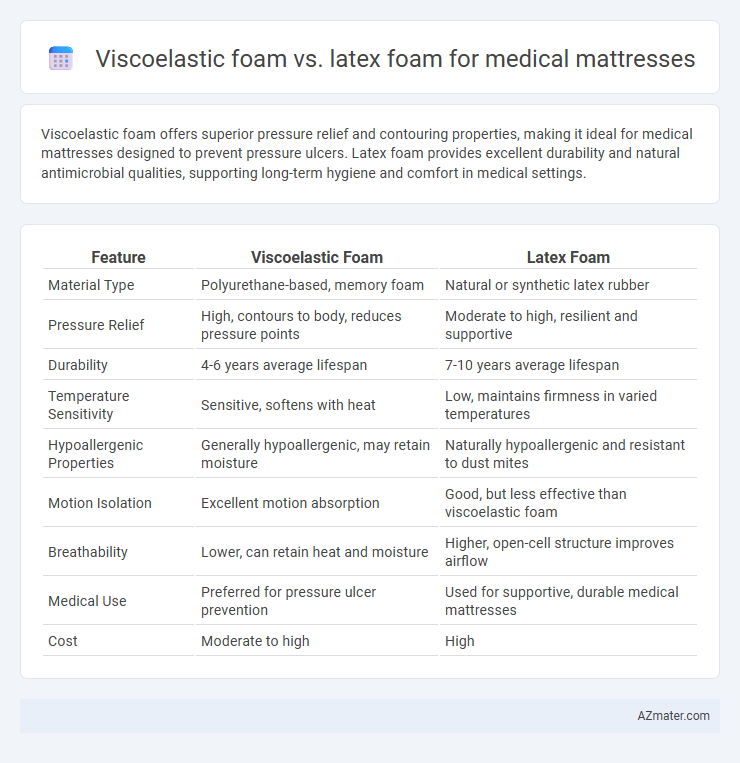Viscoelastic foam offers superior pressure relief and contouring properties, making it ideal for medical mattresses designed to prevent pressure ulcers. Latex foam provides excellent durability and natural antimicrobial qualities, supporting long-term hygiene and comfort in medical settings.
Table of Comparison
| Feature | Viscoelastic Foam | Latex Foam |
|---|---|---|
| Material Type | Polyurethane-based, memory foam | Natural or synthetic latex rubber |
| Pressure Relief | High, contours to body, reduces pressure points | Moderate to high, resilient and supportive |
| Durability | 4-6 years average lifespan | 7-10 years average lifespan |
| Temperature Sensitivity | Sensitive, softens with heat | Low, maintains firmness in varied temperatures |
| Hypoallergenic Properties | Generally hypoallergenic, may retain moisture | Naturally hypoallergenic and resistant to dust mites |
| Motion Isolation | Excellent motion absorption | Good, but less effective than viscoelastic foam |
| Breathability | Lower, can retain heat and moisture | Higher, open-cell structure improves airflow |
| Medical Use | Preferred for pressure ulcer prevention | Used for supportive, durable medical mattresses |
| Cost | Moderate to high | High |
Introduction to Medical Mattress Materials
Medical mattresses utilize viscoelastic foam and latex foam for their unique pressure-relieving properties essential in patient care. Viscoelastic foam, also known as memory foam, adapts to body shape by responding to heat and pressure, providing superior support and reducing pressure ulcers. Latex foam, derived from natural or synthetic sources, offers resilience and breathability combined with antimicrobial and hypoallergenic qualities, making both materials pivotal in optimizing comfort and hygiene in medical settings.
What is Viscoelastic Foam?
Viscoelastic foam, commonly known as memory foam, is a type of polyurethane foam enhanced with viscoelastic properties that allow it to conform closely to the body's contours, providing pressure relief and optimal support. Its slow recovery to original shape helps to distribute weight evenly, making it ideal for medical mattresses designed to prevent pressure ulcers and enhance patient comfort. Compared to latex foam, viscoelastic foam offers superior pressure redistribution and reduced shear forces, critical for long-term medical use and patient care.
What is Latex Foam?
Latex foam is a natural or synthetic material derived from rubber tree sap or petroleum-based compounds, known for its high durability, breathability, and hypoallergenic properties, making it ideal for medical mattresses. Its open-cell structure provides excellent pressure relief and support by conforming to the body while maintaining consistent firmness and resilience over time. Compared to viscoelastic (memory) foam, latex foam offers superior temperature regulation and antimicrobial resistance, promoting better patient comfort and hygiene in medical settings.
Pressure Relief Capabilities
Viscoelastic foam, often known as memory foam, offers superior pressure relief by conforming closely to body contours and evenly distributing weight, which minimizes pressure points and enhances patient comfort in medical mattresses. Latex foam provides resilient support with natural elasticity, promoting consistent pressure distribution and maintaining optimal spinal alignment, but may not contour as precisely as viscoelastic foam. Both materials are effective for pressure ulcer prevention, with viscoelastic foam excelling in pressure relief and latex foam offering durability and hypoallergenic properties.
Support and Spinal Alignment
Viscoelastic foam conforms closely to body contours, providing targeted support that helps maintain proper spinal alignment by distributing weight evenly and reducing pressure points in medical mattresses. Latex foam offers responsive support with natural elasticity, promoting spinal alignment through consistent firmness and durability, which adapts to body movements without sagging. Both foams enhance spinal support, but viscoelastic foam excels in pressure relief while latex provides more resilient, long-term structural support.
Temperature Regulation and Breathability
Viscoelastic foam, known for its temperature-sensitive properties, conforms closely to body heat, which can lead to heat retention and reduced breathability in medical mattresses. Latex foam offers superior temperature regulation through its open-cell structure and natural ventilation, promoting better airflow and moisture dissipation. This enhanced breathability in latex foam minimizes overheating risk, making it ideal for prolonged medical use requiring consistent comfort and skin integrity.
Durability and Longevity
Viscoelastic foam offers superior pressure relief but tends to degrade faster under continuous medical use, typically lasting around 5 to 7 years before significant wear appears. Latex foam boasts exceptional durability and resilience, often maintaining its structural integrity and comfort for over 10 years, making it ideal for long-term medical mattresses. Both materials provide therapeutic support, but latex's longer lifespan and resistance to sagging deliver better value for extended patient care.
Hypoallergenic and Health Considerations
Viscoelastic foam, known for its hypoallergenic properties, resists dust mites and allergens, making it suitable for medical mattresses aimed at sensitive patients. Latex foam offers natural antimicrobial benefits and breathability, reducing the risk of mold and bacteria buildup, vital for preventing infections in healthcare environments. Both materials provide orthopedic support, but latex's durability and natural resistance make it preferable for long-term health considerations.
Cost Comparison and Value
Viscoelastic foam medical mattresses generally cost less upfront compared to latex foam, making them a budget-friendly option for healthcare facilities. Latex foam offers greater durability and natural resistance to allergens and bacteria, which can reduce long-term replacement and maintenance expenses. Investing in latex foam mattresses often provides better overall value due to enhanced comfort, longevity, and patient hygiene benefits.
Which Foam is Best for Medical Use?
Viscoelastic foam, known for its pressure-relieving properties and ability to conform closely to body contours, excels in medical mattresses by reducing pressure ulcers and enhancing patient comfort. Latex foam offers superior durability, natural antimicrobial characteristics, and better breathability, making it ideal for patients with allergies or moisture concerns. For medical use, viscoelastic foam is often preferred for pressure management, while latex foam suits long-term use requiring resilience and hypoallergenic features.

Infographic: Viscoelastic foam vs Latex foam for Medical mattress
 azmater.com
azmater.com